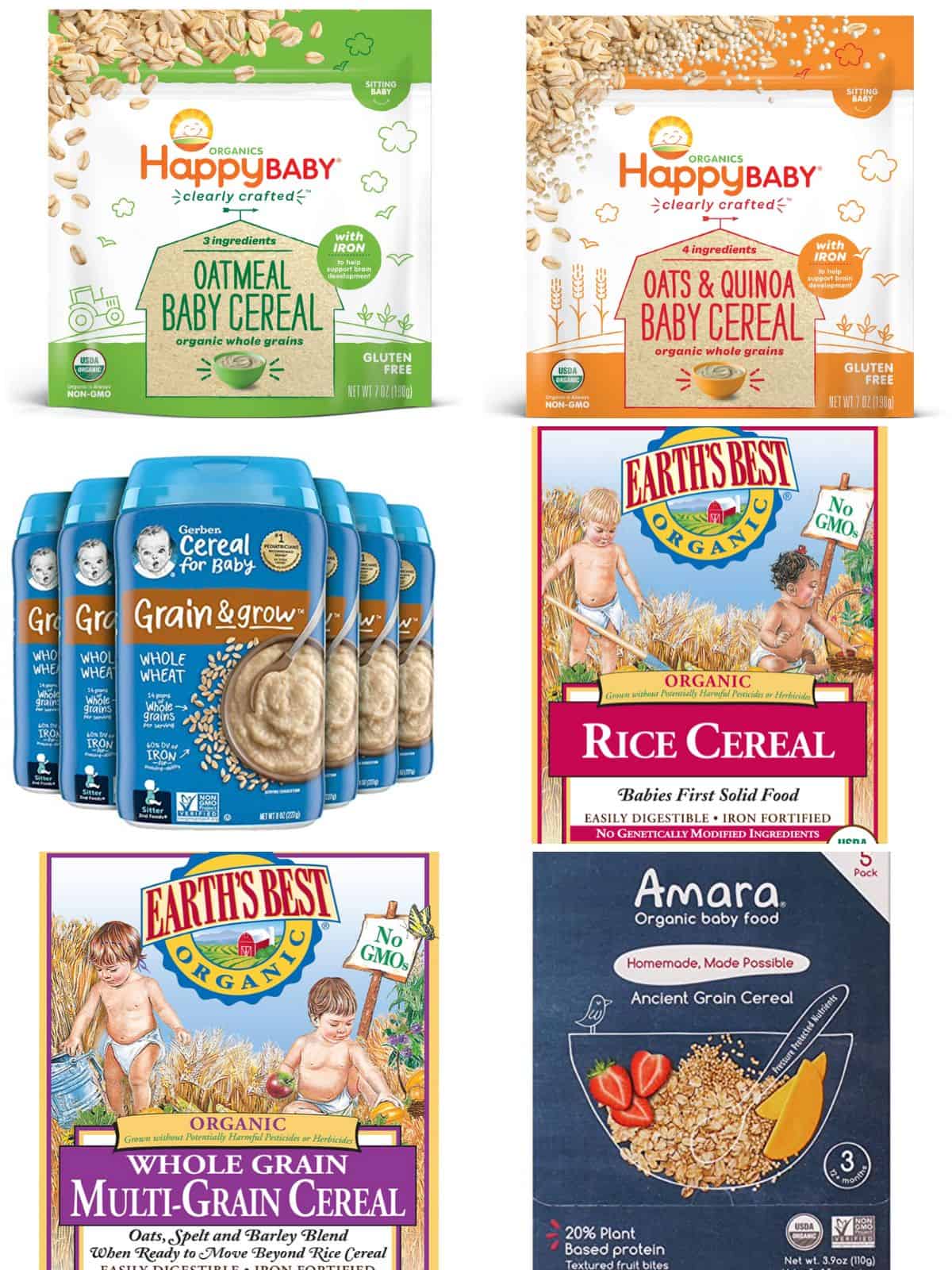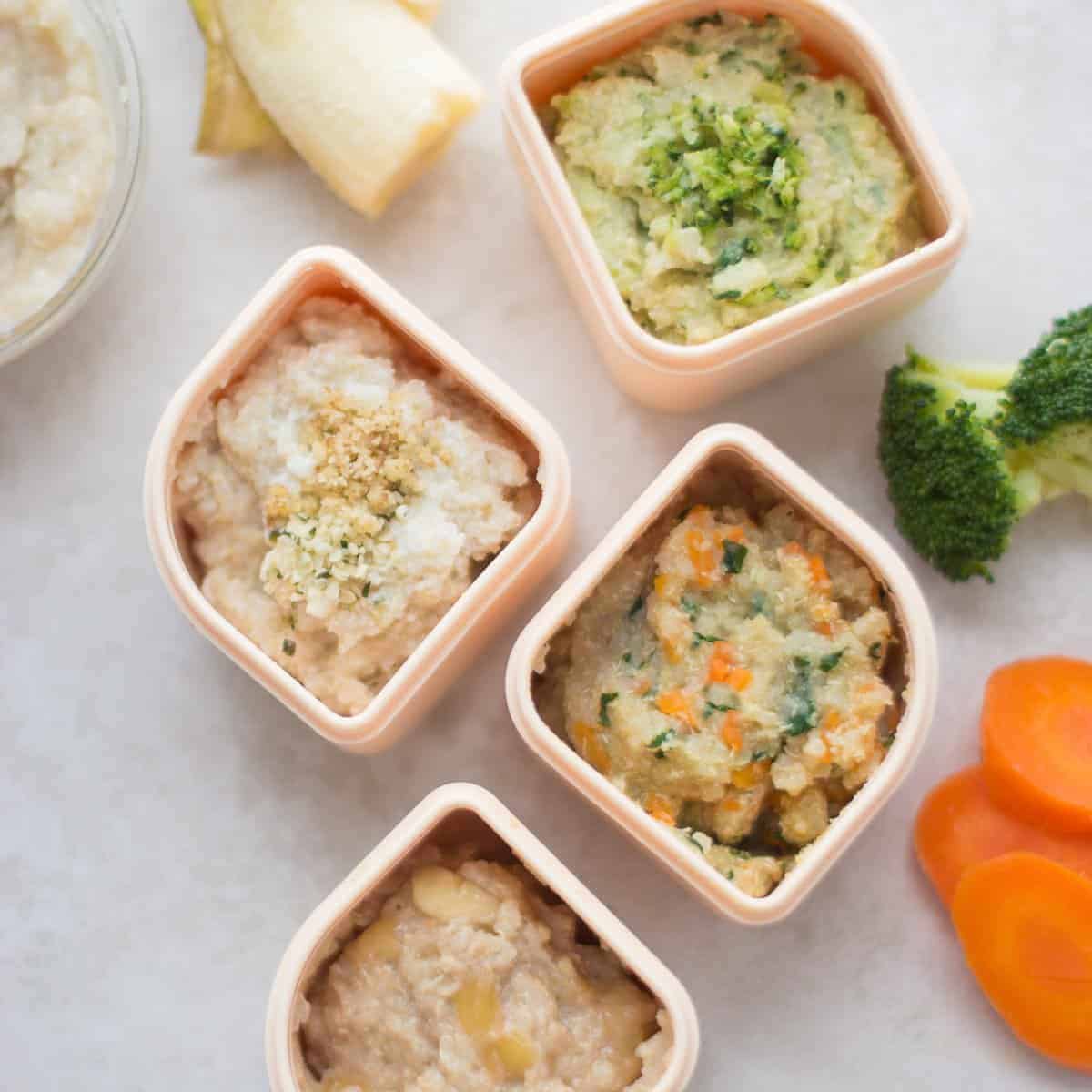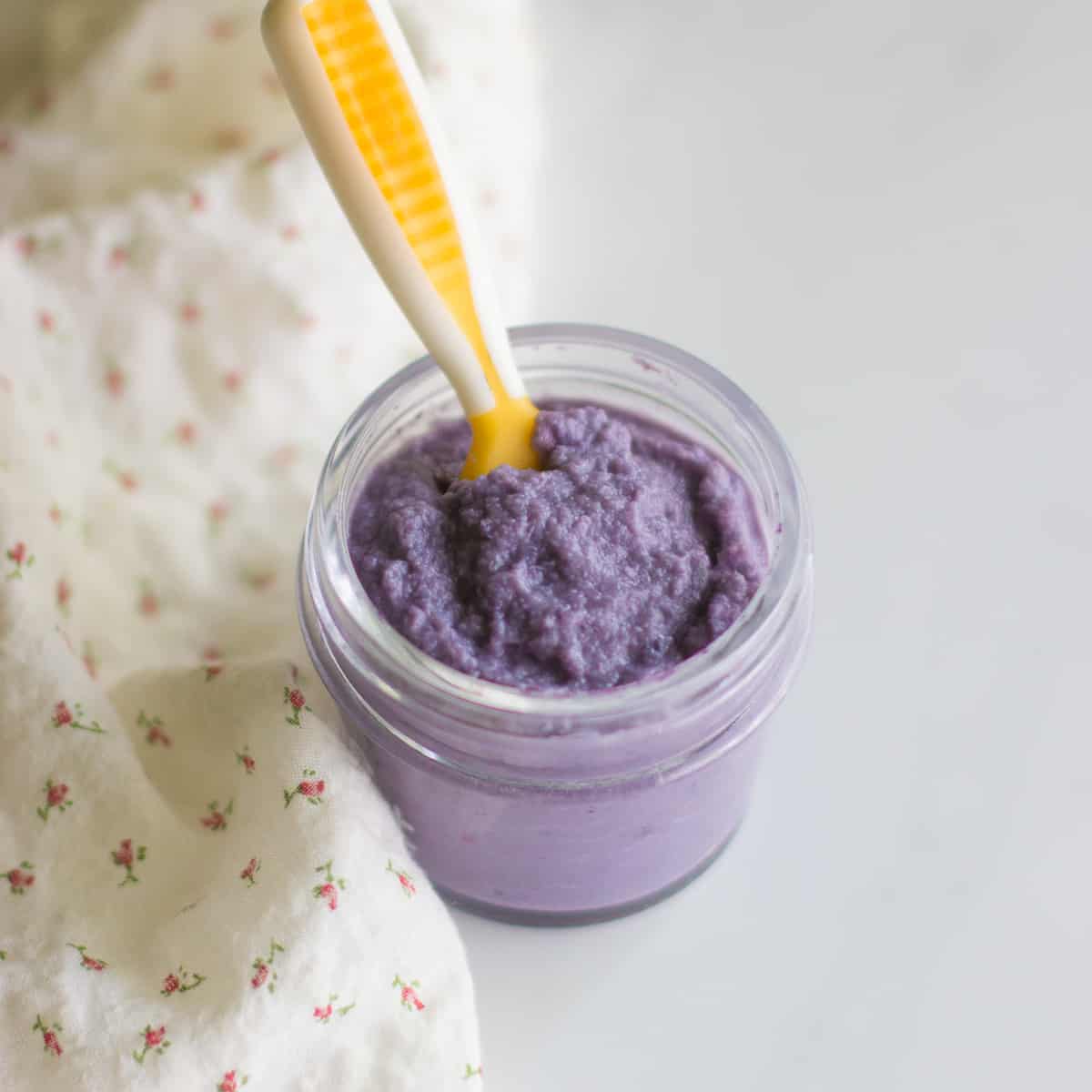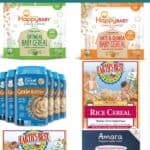This post may contain affiliate links. Please see our disclosure policy for more details.
Here’s everything you need to know about introducing and serving baby cereal to optimize nutrition and add flavors to your baby’s diet. Included are the best store-bought infant cereal options.

Table of Contents
Best Store-Bought Infant Cereals
I know how overwhelming the cereal aisle can be with so many choices, and if you have a baby at your hip, you don’t have time to investigate. So here are the top picks from me and my fellow registered dietitians as well as consumers.
- Amara Organics Ancient Grain
- Happy Baby Oatmeal
- Happy Baby Oats and Quinoa Baby Cereal
- Earth’s Best Whole Grain Multi-Grain Cereal
- Gerber Whole Wheat Baby Cereal
- Earth’s Best Whole Grain Rice Cereal
- Breakfast Variety Pack
When to Introduce
The World Health Organization, Academy of Nutrition and Dietetics, And The American Academy of Pediatrics recommends introducing foods other than breast milk or infant formula at around 6 months of age.
Keep in mind age is just a guide. It’s not as if a switch flips on when your baby turns a certain age and they’re ready to start solids. What’s most important is paying close attention to your baby’s signs of readiness. As with all milestones, watch your baby, not the calendar.
Not sure if your baby is ready? Grab my FREE handout that will ensure you start at the most optimal time.

Is your baby 6 months old and up?
Learn all the secrets to starting solids safely while optimizing nutrition!
Benefits of Baby Cereal
- Quick and easy to prepare.
- A convenient source of iron, vitamins, and minerals that your baby needs
- Most babies accept it pretty readily
- Easy to digest
- Can help ease the transition from breast milk or formula to solid foods
While iron-fortified baby cereal is a good starter food, it shouldn’t be the only source, and does not need to be baby’s first food.
The best thing you can do is offer the cereal along with a variety of other foods to ensure your baby gets all the important nutrients they need to grow and thrive.
Best Iron Rich Foods for Babies
How to choose best baby cereals
The good news is there are so many nutritious and high-quality varieties available that are made with a variety of different ingredients. You can choose a single-grain cereal, such as oat, barley, quinoa, or rice, or a multi-grain cereal with two or more.
Here’s what to look for:
1. Fortified with Iron
Babies are born with iron stores built up during their time in the womb. And this is why moms need to maintain a healthy iron status during pregnancy. But by 6 months of age, it becomes depleted. At the same time, their iron needs increase drastically to support their rapid growth and development.
Thus, it’s very important to prioritize serving iron-rich foods at EVERY meal. Baby cereals can help meet their high needs. And some of them have vitamin C, which greatly enhances the absorption of iron.
2. Minimally processed
Before looking at anything else, check out the ingredient label first! Make sure there are no artificial flavors, colors, added sugars, salts, etc.
I especially love Amara Baby Food because they use a patented technology that preserves whole foods in their original structure so that the ingredients retain their flavor, texture, color, and nutritional profile with 1/3 less natural sugar than other leading baby food brands. Be sure to use the code MIN5 for $5 discount!
3. Organic, if possible
Organic baby cereal contains less pesticide residue than non-organic. But they are similar in regards to nutrition. If you are on a budget, you should NOT feel bad or guilty for going with non-organic infant cereal. Fed is best, and I truly believe that.
4. Aim for variety
It’s easy to fall back on the same cereal that your baby seems to enjoy the most. But this stage is all about introducing a wide variety of foods, so expose your baby to a variety of different cereals.
How to serve cereal to babies

Regardless of which feeding method you choose, pureed foods or baby-led weaning, baby cereal can be a great first food.
If you’ve heard that you can ONLY serve finger foods to your baby with baby led weaning, that is not true!
Including iron-fortified infant cereal along with finger foods, such as broccoli, banana, avocado, etc., is a great way to help your baby meet their iron needs.
Here are some creative ways to serve cereal to your baby.
Tip: Don’t shy away from introducing a variety of colors, flavors, and textures from the beginning. It will help ensure your baby gets an assortment of essential nutrients, pique interest in eating, and may even minimize picky eating down the road.

- If doing purees, you can start with the thin consistency but quickly move forward with texture by adding less liquid to make it thicker.
- Instead of serving it plain, combine with yogurt, smoothies, pureed or mashed fresh (or frozen) fruits and vegetables, beans, chicken, tofu, eggs, salmon, etc. These are all great first foods.
- Add healthy fats, like peanut butter, nut or butters, hemp seeds, avocado, olive oil, etc.
- Coat slippery foods, like avocado and mango with some infant cereal to add grip (can also do this with nuts and seeds)
- Use powdered baby cereal in recipes that call for breadcrumbs or oats, like meatballs, burgers, veggie nuggets, and salmon patties.
Tip: You can easily make Quinoa baby cereal at home!
Frequently Asked Questions
Absolutely! As a pediatric registered dietitian, I 100% stand by them. And rather than serving it plain, mix in other foods, like yogurt, pureed or mashed fruits, vegetables, peanut butter, eggs, etc.
This is such a great way to make every bite count and invite fun and variety into your baby’ diet.
The main concern is the high levels of arsenic found in rice cereals. And while steps are being taken to reduce the arsenic levels, according to a recent Consumer Reports article, they are still high.
And while brown rice is more nutritious than white rice, it contains higher amounts of arsenic, because it contains the bran (the outer portion of the rice grain), which is where the arsenic accumulates.
Having said this, rice is such an integral part of many cultures around the world and there is no need to avoid completely. An occasional serving (no more than twice a week of rice cereal or any rice-based foods is fine and can be a part of a balanced diet.
My top suggestion is to mix it up with other grains, like barley, oats, quinoa, etc. I can’t emphasize this enough – VARIETY is the key to protecting your baby from over-exposure to heavy metals found in food.
You can truly start with any type of cereal. Oats, barley, or any whole grain…all are great! Always aim for variety and try different grains or even brands of cereal.
It is not a requirement so you don’t have to serve it if you don’t want to!
What is most important is that you prioritize iron-rich foods. Infant cereal is a convenient and reliable source of iron, but if you are able to serve any of these iron-rich foods at every single meal, then you are on the right track!
There is so much misinformation out there about how babies shouldn’t have grains because they are hard to digest.
The argument is that babies don’t make enough amylase, an enzyme responsible for digesting complex carbohydrates, until they are at least one year old. I chuckle because that would mean babies can’t digest fruits and vegetables. So then should we not introduce these foods either?
Here’s what the research shows.
While it’s true that they make very little pancreatic amylase, they produce plenty of salivary amylase, which is responsible for the beginning of carbohydrate breakdown, and other enzymes that help break down starch. And if they are breastfed, they will receive quite a bit of amylase from mother’s milk.
All this to say, your baby CAN digest grains and can introduced as a part of a healthy diet. They provide energy, fiber, and vitamins and minerals, such as B vitamins and iron.
And as your baby grows older and is ready for dry cereal, try these healthy cereals for babies and toddlers!















Very informative, thank you!
I’m glad you found this to be helpful!